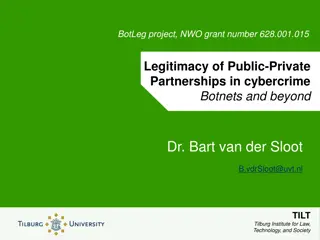
Company Conversion from Private to Public and vice versa-Step-by-Step Approach
The Companies Act, 2013 outlines the process for converting a Private Limited Company into a Public Limited Company and vice versa. Conversion from private to public allows access to wider capital markets and increased credibility, while the reverse
Download Presentation

Please find below an Image/Link to download the presentation.
The content on the website is provided AS IS for your information and personal use only. It may not be sold, licensed, or shared on other websites without obtaining consent from the author. If you encounter any issues during the download, it is possible that the publisher has removed the file from their server.
You are allowed to download the files provided on this website for personal or commercial use, subject to the condition that they are used lawfully. All files are the property of their respective owners.
The content on the website is provided AS IS for your information and personal use only. It may not be sold, licensed, or shared on other websites without obtaining consent from the author.
E N D
Presentation Transcript
Affluence Advisory Pvt. Ltd. From Private to Public and vice versa: Step-by-Step Approach to Company Conversion I.Introduction: The Companies Act, 2013 provides a detailed process for the conversion of a Private Limited Company into a Public Limited Company and vice versa. Such conversions are typically done to access broader markets, invite public investments, or to benefit from the more flexible structure of private companies. Below is an overview of the procedures for each type of conversion. II.Conversion of a Private Company into a Public Company: A private company can convert itself into a public company to raise capital from the general public, gain credibility, or list its shares on stock exchanges. However, such conversion requires adherence to specific statutory requirements under the Companies Act, 2013. Key Provisions Involved: Section 13: Alteration of Memorandum of Association ( MOA ). Section 14: Alteration of Articles of Association ( AOA ). Step-by-Step Procedure: 1.Convene a Board Meeting: The Board of Directors must first meet to approve the conversion proposal and decide the date, time, and venue of an Extraordinary General Meeting ( EOGM ). The purpose of the EOGM will be to seek shareholder approval for the conversion. 2.Alteration of Memorandum and Articles of Association: Amendments to the MOA and AOA are required to eliminate the restrictions imposed on a Private Company. Key changes include removing clauses that restrict the transfer of shares and limitations on the number of members. 3.Pass a Special Resolution: A special resolution is required for the conversion, which needs to be passed in the EOGM. The resolution should specifically approve the amendment of the MOA and AOA. 4.File Forms with ROC: After the conclusion of EOGM, the company must file Form MGT- 14 with the Registrar of Companies ( ROC ) within 30 days to notify ROC about the special resolution and the alteration made to the MOA and AOA. 5.Increasing Number of Directors: As per Section 149(1) of the Companies Act, 2013, a Public Company must have a minimum of three directors. Ensure that the company complies with this requirement before proceeding. CS Tanvi Shah | Affluence Advisory Pvt. Ltd. | Website - www.affluence.net.in |Email - connect@affluence.net.in
Affluence Advisory Pvt. Ltd. From Private to Public and vice versa: Step-by-Step Approach to Company Conversion 6.File Conversion Application: The Company must submit Form INC-27 with ROC, requesting conversion from Private to Public. Along with this, the company must attach documents like the special resolution, amended MOA and AOA, and minutes of the EOGM. 7.Fresh Certificate of Incorporation: Once the ROC is satisfied with the application, a fresh Certificate of Incorporation will be issued. This marks the formal conversion of the Company into a Public Company. 8.Post-Conversion Compliance: After conversion to a public limited company, compliance with the rules and regulations applicable to public companies are mandatory. This includes the requirement to hold statutory meetings, file annual returns, etc. III.Conversion of a Public Company into a Private Company Converting a Public Company into a Private Company allows the Company to limit external interference, reduce compliance requirements, and operate with greater flexibility. However, such a conversion is subject to a more stringent process, including obtaining approval from the National Company Law Tribunal ( NCLT ). Key Provisions Involved: Section 13: Alteration of Memorandum of Association (MOA). Section 14: Alteration of Articles of Association (AOA). Rule 41 of the Companies (Incorporation) Rules, 2014. Step-by-Step Procedure: 1.Convene a Board Meeting: The Board of Directors must approve the conversion proposal and fix the date, time, and venue of the EOGM, where shareholder approval will be sought. 2.Alteration of Memorandum and Articles of Association: The MOA and AOA must be amended to include the restrictions applicable to private companies under Section 2(68). These changes include: a.Restricting the right to transfer shares. b.Prohibiting invitations to the public for subscribing to shares. c.Limiting the maximum number of shareholders to 200. CS Tanvi Shah | Affluence Advisory Pvt. Ltd. | Website - www.affluence.net.in |Email - connect@affluence.net.in
Affluence Advisory Pvt. Ltd. From Private to Public and vice versa: Step-by-Step Approach to Company Conversion 3.Pass a Special Resolution: In the EOGM, the shareholders must approve the conversion by passing a special resolution. This resolution must be filed with the ROC in Form MGT-14 within 30 days. 4.Obtain Approval from NCLT: Unlike the conversion from a Private Company to a Public Company, converting a Public Company to a Private Company requires approval from the National Company Law Tribunal (NCLT). An application must be made in Form INC-27, along with: a.A copy of the special resolution. b.Altered MOA and AOA. c.List of members and creditors. d.Affidavit verifying the application. e.Minutes of the EGM and other relevant documents. 5.Issue of Notice to Authorities: The Company must serve notices of the application to the ROC and other regulatory authorities as directed by the NCLT. 6.Hearing by NCLT: The NCLT will hear the case and consider any objections raised by stakeholders before passing an order approving or rejecting the conversion. 7.File NCLT Order with ROC: Upon obtaining approval from NCLT, the Company must file the NCLT order with the ROC in Form INC-28 within 30 days. 8.Issuance of Fresh Certificate of Incorporation: Upon receipt of the NCLT order, the ROC will issue a fresh Certificate of Incorporation acknowledging the Company's conversion into a Private Company. 9.Post-Conversion Compliance: Once the conversion is complete, the Company must follow the regulatory requirements applicable to private companies, including changes in reporting and governance structures. Key Differences between the Two Conversions: a.Private to Public: Requires only ROC approval and is relatively simple compared to the reverse. b.Public to Private: Requires approval from both ROC and NCLT, making it a lengthier and more complicated process. CS Tanvi Shah | Affluence Advisory Pvt. Ltd. | Website - www.affluence.net.in |Email - connect@affluence.net.in
Affluence Advisory Pvt. Ltd. From Private to Public and vice versa: Step-by-Step Approach to Company Conversion Conclusion The conversion process under the Companies Act, 2013, is thorough and must be carried out with utmost care to avoid regulatory non-compliance. While converting a private company to a public company enables access to broader capital markets, the reverse process of converting a public company into a private one can reduce the compliance burden and increase operational flexibility. For both types of conversions, it is critical to adhere to the timelines, documentation requirements, and legal procedures set out in the law. Companies should seek professional advice to ensure a smooth transition while managing the complexities involved. Disclaimer:This article provides general information existing at the time of preparation and we take no responsibility to update it with the subsequent changes in the law. The article is intended as a news update and Affluence Advisory neither assumes nor accepts any responsibility for any loss arising to any person acting or refraining from acting as a result of any material contained in this article. It is recommended that professional advice be taken based on specific facts and circumstances. This article does not substitute the need to refer to the original pronouncement CS Tanvi Shah | Affluence Advisory Pvt. Ltd. | Website - www.affluence.net.in |Email - connect@affluence.net.in






















